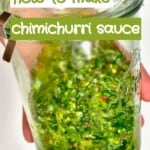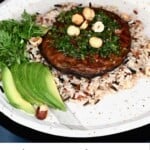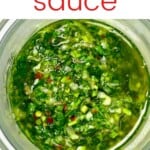This post may contain affiliate links. Please read our disclosure policy.
How to make chimichurri sauce (Chimichurri Verde aka parsley chimichurri), a fresh green herby sauce made with 7 simple ingredients. Plus, two bonus variations: mint chimichurri and cilantro chimichurri! Best of all, this Argentinian chimichurri takes just minutes to prepare and can be used in several ways!
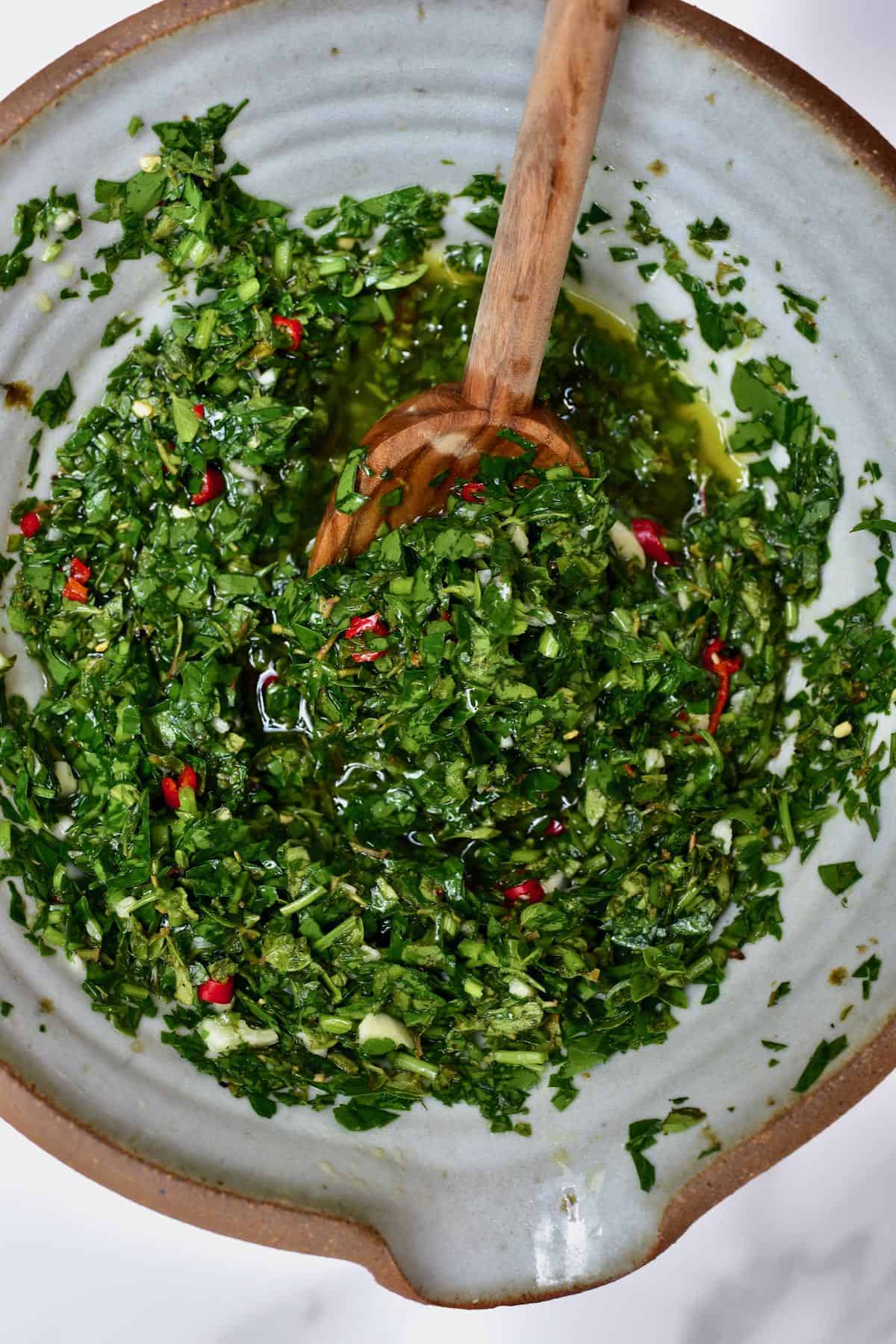
I love to have a handy selection of versatile condiments in my kitchen at all times, including homemade mayonnaise, homemade ketchup, Lebanese garlic sauce (toum), and something herby like this chimichurri sauce.
Learning how to make chimichurri sauce is incredibly simple and takes just a couple of steps and a few minutes at most. Made from just a few fresh herbs and several pantry staples, this homemade chimichurri is the ultimate simple, fresh sauce/condiment.
If you grow your own herbs, even better! In this post, I’ve included how to make an authentic chimichurri recipe alongside a couple of other herby options with mint or cilantro!
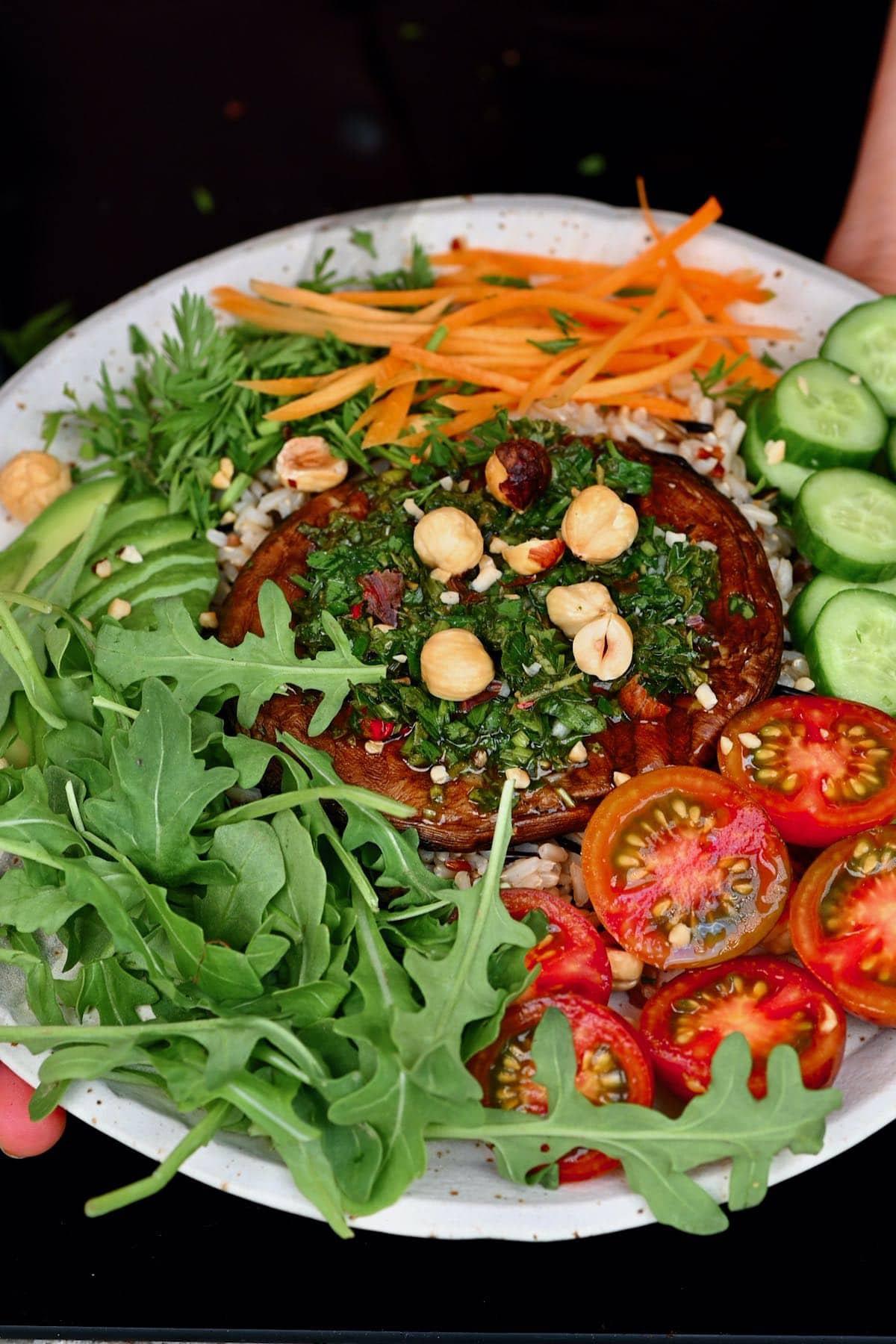
Chop by hand or using a mini food processor, then serve over proteins, salads, pizza, sandwiches, and more (check below for suggestions). No matter which herbs you use, homemade chimichurri sauce contains a fantastic depth of flavor – herby, earthy, tangy, and robust! You’ll want to serve it over everything!
Want to save this recipe?
What is Chimichurri sauce?
Chimichurri sauce is an uncooked herby oil-based sauce/condiment originating in Spain and found in Spanish, Argentinian, Uruguayan, and Paraguayan cuisine – similar in ways to fresh Italian pesto and Mexican Salsa Verde. It is popularly used to baste and spoon over meats like steak as they cook or served as an accompaniment to grilled meat, poultry, and fish (like baked salmon).
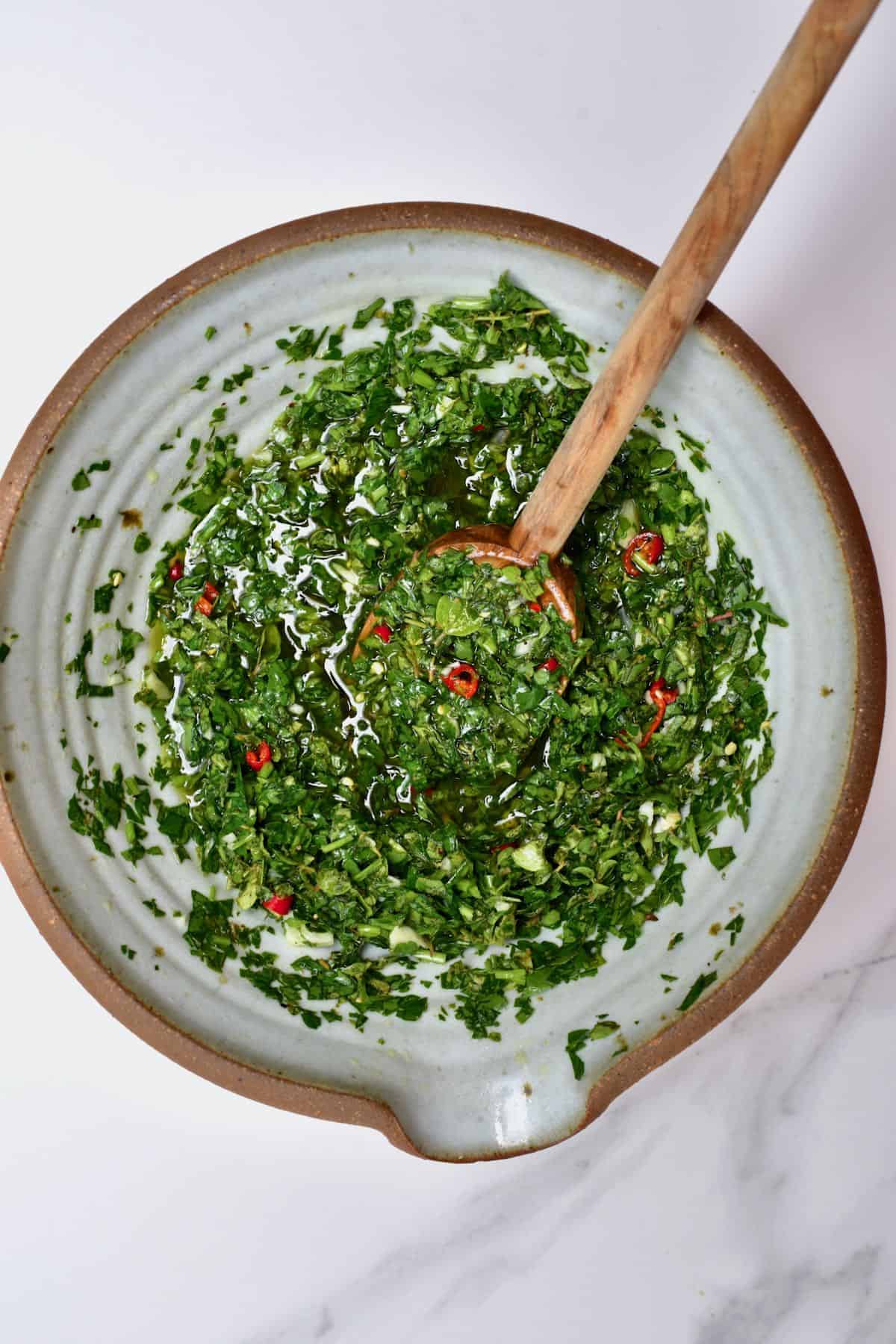
What is in Chimichurri sauce?
It’s traditionally made with a combination of parsley, oregano, garlic, olive oil, and red wine vinegar (chimichurri Verde). Though there is also a red version (chimichurri Roja).
Since the beginning, chimichurri sauce recipes have been tweaked and vary wildly with additions of other herbs, red pepper flakes, and extra aromatics like shallots, onion, or lemon juice. I’ll be sharing how to make chimichurri sauce the authentic way (Argentinian chimichurri aka parsley chimichurri), plus two variations: cilantro chimichurri and mint chimichurri.
The Chimichurri ingredients
Authentic chimichurri recipe
- Parsley: I used flat parsley, but curly parsley works too.
- Oregano: you can use fresh or dried oregano, though fresh is best.
- Oil: I like to use high-quality extra virgin olive oil. However, you could use another neutral oil like canola or sunflower oil (the traditional Argentine chimichurri option).
- Red wine vinegar: you can substitute this with white wine vinegar, though the flavor will vary.
- Aromatics: garlic, lime juice (optionally some zest, too – though that isn’t authentic), and salt and pepper are all classic additions to authentic chimichurri. Feel free to adjust the amount of garlic used to personal preference.
- Chili: I used fresh, finely chopped chilies. Feel free to use dried chili flakes instead and adjust the amount to personal preference. This addition is more like an authentic Uruguay chimichurri rather than Argentinian (according to a friend) – but it is a delicious addition.
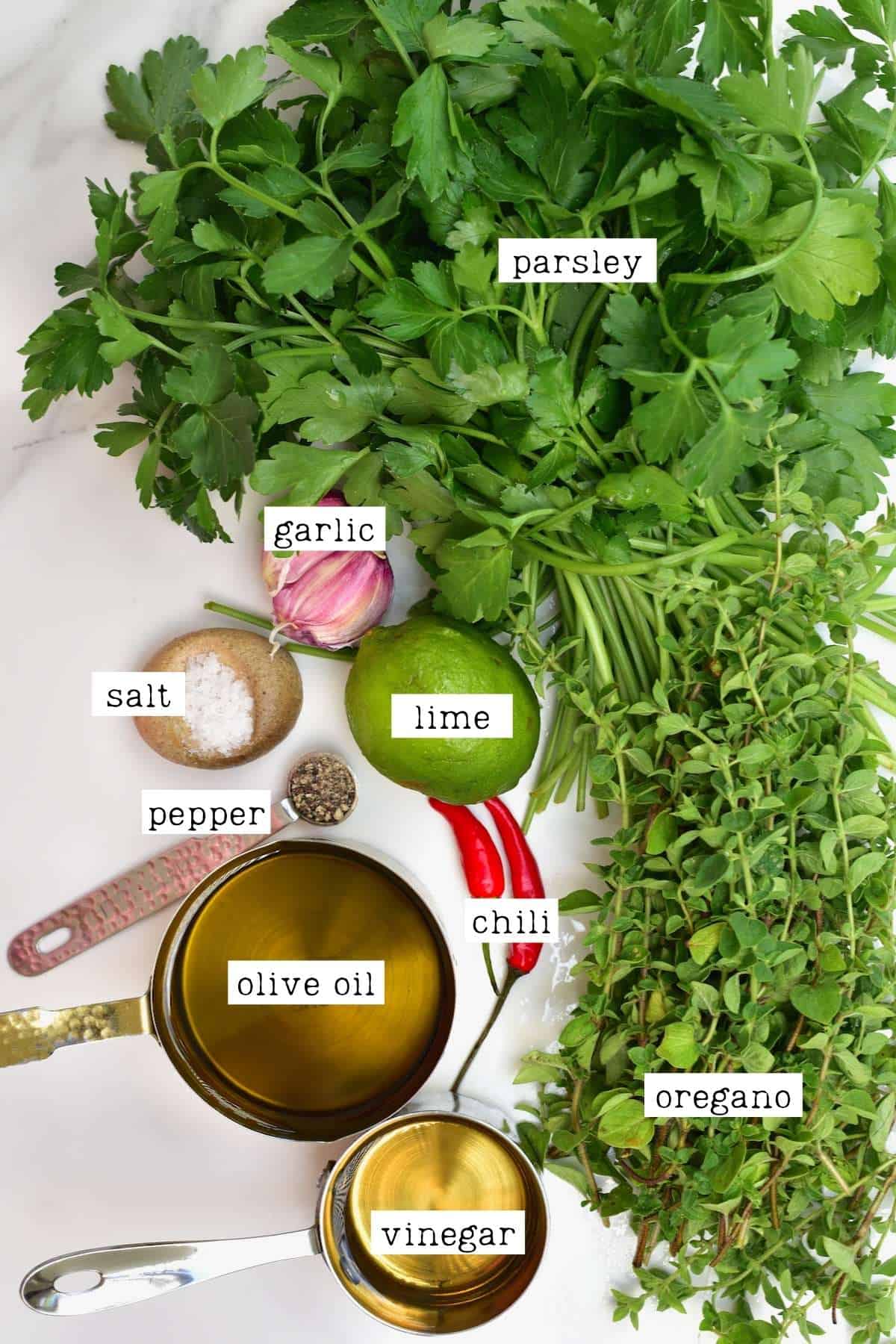
Chimichurri variations
- Cilantro chimichurri: use a 75:25 blend of cilantro and parsley and either omit the oregano or reduce it to just 1-2 Tbsp (or more, to taste).
- Mint chimichurri: omit the oregano and use a 50:50 blend of parsley and fresh mint leaves for a delicious mint chimichurri.
Optional add-ins and variations
- Onion/Shallots/Scallions.
- Rosemary/Thyme.
- Paprika (pimentón): for a smoky flavor, you can add a little smoked paprika (1/4 tsp then increase to personal preference).
- Infused oil: you can use infused oils like garlic-infused oil or EVOO plus a little chili oil for extra flavor.
- Balsamic vinegar: removing a little of the red wine vinegar and replacing it with a fruity balsamic (like raspberry) – it adds a subtle sweetness that tastes surprisingly delicious with this easy chimichurri sauce.
How to make chimichurri sauce
Step 1: Chop the fresh herbs
First, prepare the herbs by rinsing and drying them. Then finely chop with a sharp knife.
Peel the garlic with one of these methods. Then chop the garlic and chili or use a mini food processor to finely chop them.
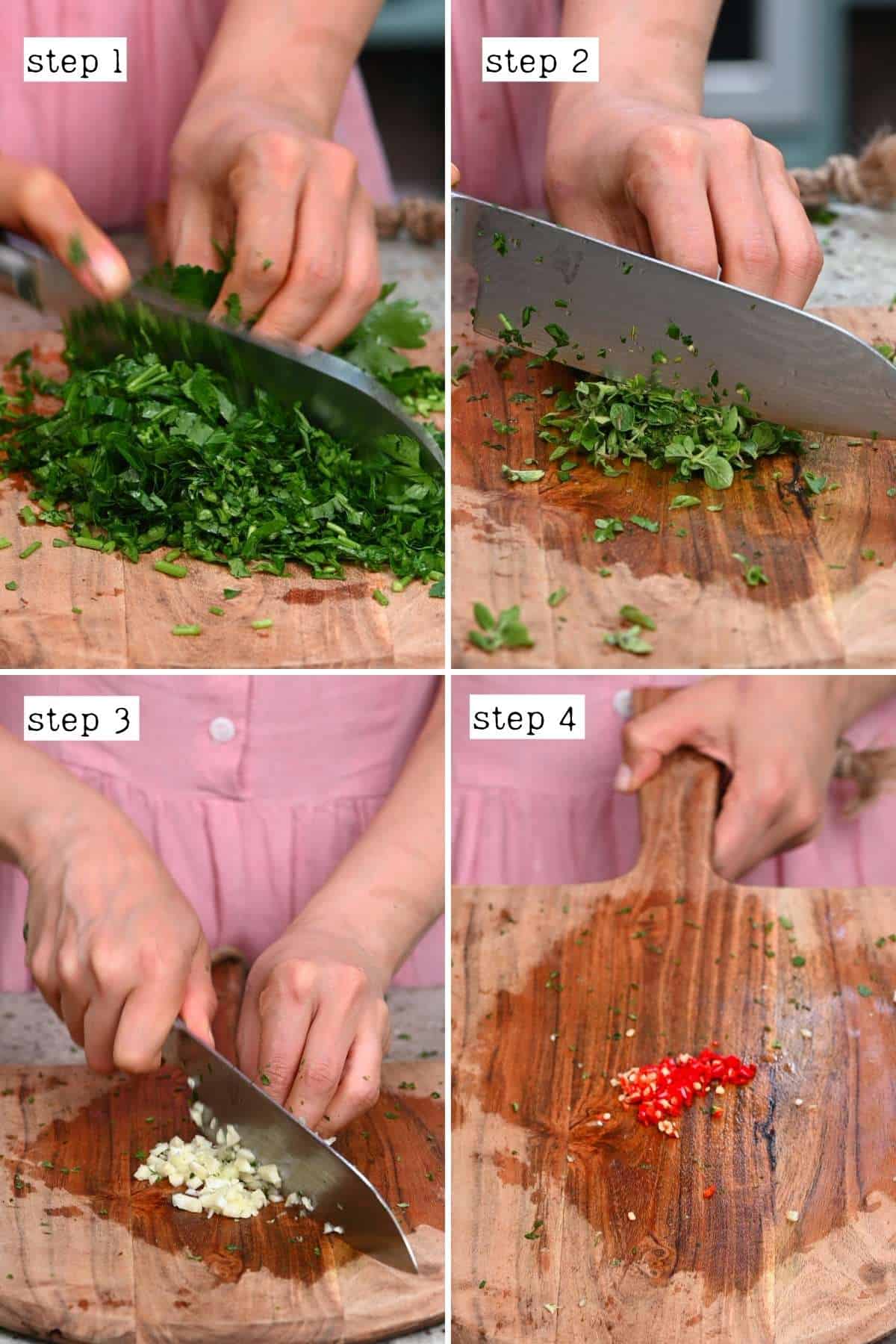
Step 2: Mix the remaining ingredients
Add the chopped ingredients to a bowl and add the oil, vinegar, lime juice, and salt and pepper, then stir to mix well.
Taste the chimichurri sauce and adjust any of the ingredients to personal preference – then enjoy!
I recommend allowing the sauce to sit and “marinate” for 20-30 minutes before serving. That way, the flavors will combine and meld for an even better taste!
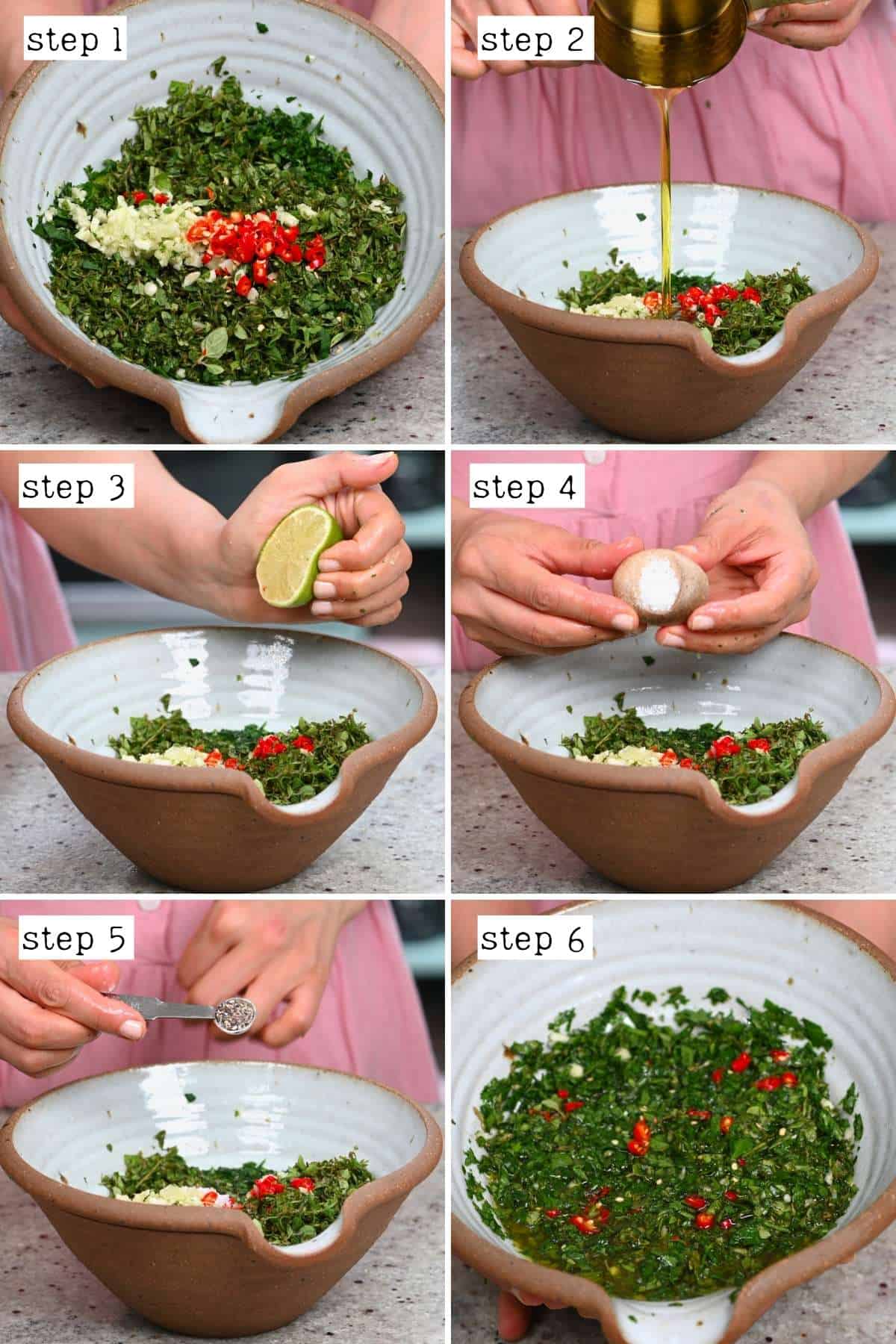
How to store
Store the chimichurri sauce in an airtight glass container in the fridge for between 1-2 weeks. While fresh herbs usually last a very short time, the oil helps preserve them for longer, so you should get at least a week out of it.
The oil may solidify in the fridge, so make sure to bring it to room temperature before serving.
You can also freeze the chimichurri sauce by pouring it into an ice-cube tray. Transfer to a freezer-safe bag/container for up to a month and then just pop out an ice cube (or more) as needed. The herbs probably won’t look quite as fresh upon thawing, but it’ll taste great!
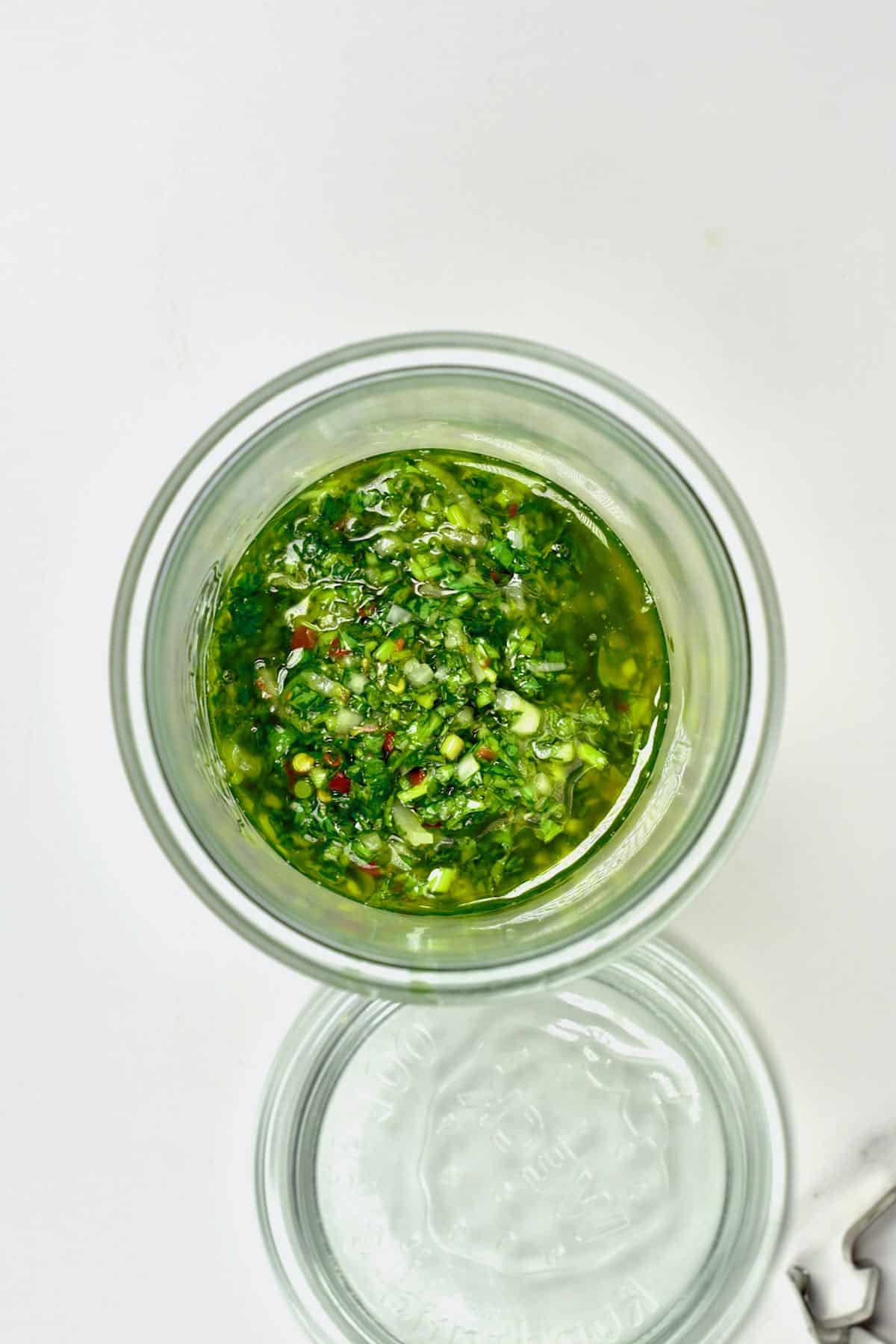
How to use chimichurri sauce
While Argentinian chimichurri is known as a meat condiment, there are tons of ways to enjoy it, including:
- For meat and seafood: use as a marinade, baste, and spoon over the final cooked meat: beef, pork, fish, shrimp, etc. You could also use it with meat alternatives and tofu!
- Over steamed/roasted veggies: like smashed potatoes, roasted cauliflower, mushroom steak, Meditteranean roasted veggies, etc.
- Salad dressing: this chimichurri sauce is versatile enough for leafy salads, grain salads, and simple veggie salads like Caprese salad.
- Grain bowls: like this burrito bowl and other quinoa/rice bowls.
- Pasta sauce: particularly for cold pasta salads.
- Sandwiches/Wraps: you can spread this parsley, mint, or cilantro chimichurri over sandwiches, wraps, quesadillas, bagels, pita, etc. This tastes surprisingly delicious with avocado toast and mushroom toast, too.
- Eggs: serve over or in egg dishes like scrambled eggs (or tofu scramble), veggie omelettes, baked eggs, and even shakshuka.
- Herby dip: transform the homemade chimichurri into a quick dip by combining it with a little mayonnaise (best for spreading) or Greek Yogurt (for dipping).
- Pizza sauce: spread a little over any pizza like this Neapolitan pizza, butternut squash pizza, or zucchini pizzas!
- Tacos: drizzle over the tacos of your choice – like these mushroom tacos, in place of salsa.
- Garnish dips: like this garlic white bean dip or creamy hummus.
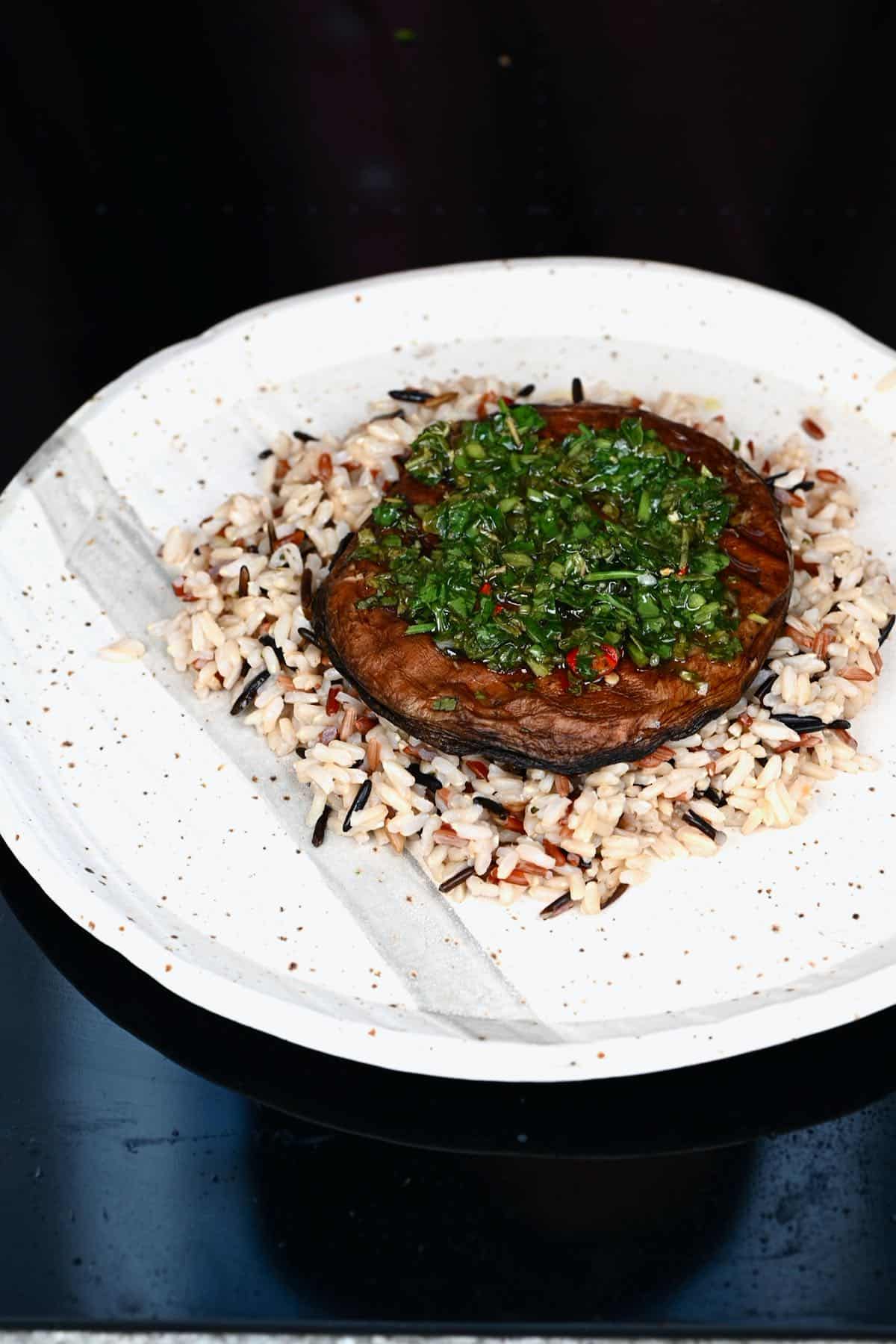
Recipe notes
- Using a food processor: you can use a mini food processor for the entire recipe if preferred. Start by processing the chili and garlic, then add in the herbs.
- Food processor vs. hand-chopped: while a food processor is handy, try not to over-process the ingredients.
- A heat-free version: the red chili in this chimichurri sauce recipe is 100% optional. Feel free to reduce it or omit it entirely.
- Using dried herbs: using fresh is best, but you can also use dried herbs and add some warm water to help hydrate the herbs.
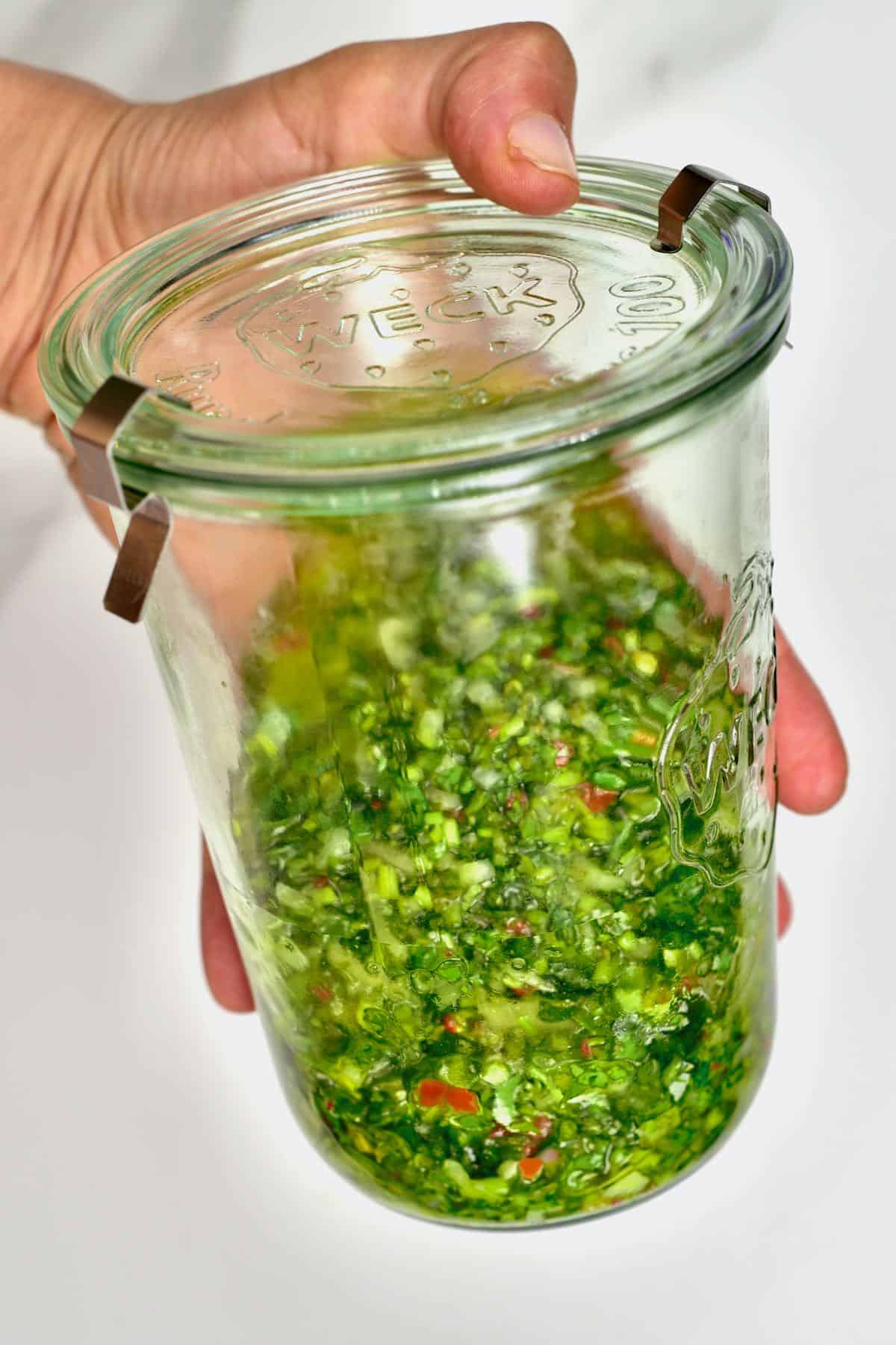
Other simple sauce recipes
- Homemade harissa sauce
- Garlic and chili-infused honey
- Authentic Greek tzatziki
- Mexican Salsa Roja Recipe (Roja Sauce)
- Tomatillo Green Chili Salsa (Salsa Verde)
- Mango Salsa (Mango Pico De Gallo)
- Quick gyoza sauce
- Pico De Gallo (Salsa Fresca)
If you try this Argentinian chimichurri sauce recipe (or the mint and cilantro variations), I’d love to hear your thoughts/questions below. Also, I’d appreciate a recipe card rating below, and feel free to tag me in your recipe recreations on Instagram @Alphafoodie!
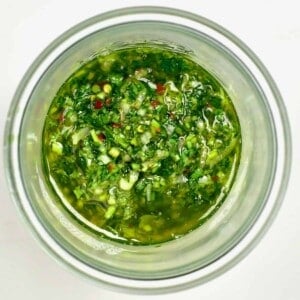
How to Make Chimichurri Sauce (Authentic chimichurri + variations)
Ingredients
- 3.5 oz parsley I used flat but curly will work too
- 1.8 oz oregano fresh or dried (reduce amount accordingly)
- 1 cup olive oil or canola or sunflower oil
- 1/3 cup white wine vinegar
- 2 garlic adjust to taste
- 1 lime 2 Tbsp
- 1/2 tsp salt
- 1/4 tsp black pepper
- 2 fresh chili or chili flakes (optional)
Instructions
Step 1: Chop the fresh herbs
- Prepare the herbs by rinsing and drying them. Then finely chop with a sharp knife.
- Chop the garlic (first peel it using one of these easy methods) and chili or use a mini food processor to finely chop them.
Step 2: Mix the remaining ingredients
- Add the chopped ingredients to a bowl and add the oil, vinegar, lime juice, and salt and pepper, then stir to mix well.
- Taste the chimichurri sauce and adjust any of the ingredients to personal preference – then enjoy!I recommend allowing the sauce to sit and "marinate" for 20-30 minutes before serving. That way, the flavors will combine and meld for an even better taste!
How to Store
- Store the chimichurri sauce in an airtight glass container in the fridge for between 1-2 weeks. While fresh herbs usually last a very short time, the oil helps preserve them for longer, so you should get at least a week out of it.The oil may solidify in the fridge, so make sure to bring it to room temperature before serving.You can also freeze the chimichurri sauce by pouring it into an ice-cube tray. Transfer to a freezer-safe bag/container and then just pop out an ice cube (or more) as needed. The herbs probably won’t look quite as fresh upon thawing, but it’ll taste great!
Notes
- Using a food processor: you can use a mini food processor for the entire recipe if preferred. Start by processing the chili and garlic, then add in the herbs.
- Food processor vs. hand-chopped: while a food processor is handy, try not to over-process the ingredients.
- A heat-free version: the red chili in this chimichurri sauce recipe is 100% optional. Feel free to reduce it or omit it entirely.
- Using dried herbs: using fresh is best, but you can also use dried herbs and add some warm water to help hydrate the herbs.
- Cilantro chimichurri: Use a 75:25 blend of cilantro and parsley and either omit the oregano or reduce it to just 1-2 tbsp (or more, to taste).
- Mint chimichurri: Omit the oregano and use a 50:50 blend of parsley and fresh mint leaves for a delicious mint chimichurri.
- Onion/Shallots/Scallions
- Rosemary/Thyme
- Paprika (pimentón): for a smoky flavor, you can add a little smoked paprika (1/4 tsp then increase to personal preference).
- Infused oil: you can use infused oils like garlic-infused oil or EVOO plus a little chili oil for extra flavor.
- Balsamic vinegar: removing a little of the red wine vinegar and replacing it with a fruity balsamic (like raspberry) adds a subtle sweetness that tastes surprisingly delicious with this easy chimichurri sauce.
Nutrition
Nutrition information is automatically calculated, so should only be used as an approximation.


